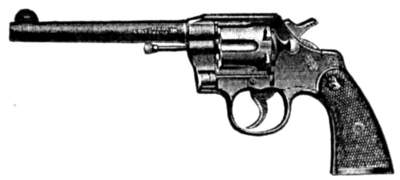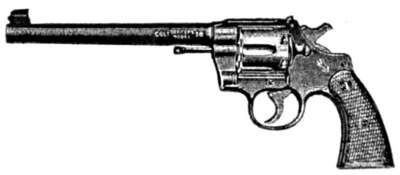The following information on choosing the best police revolver comes from Section 39 of Shooting by J. Henry FitzGerald. Shooting is also available to purchase in print.
The first thing an officer requires is a serviceable revolver, one that is safe and reliable, and will function perfectly when his life is in danger. He may carry any caliber from .32 to .45, but if he can place his shots and place them quickly all calibers of arms are effective. The heavy calibers are, of course, preferable and safer for the officer to use, as a slightly misplaced shot will cause the desired result. As the old saying goes: “In a gun fight the little arms will hide under the thumb nail, but you feel like a he-man with a .45 in your hand.
It is well to remember that the gunmen of today are carrying .38 and .45 caliber arms; in many cases the .45 automatic pistol. It is true that small caliber arms will kill but will they kill quick enough to prevent the criminal from killing the officer? It is all very well to speak of placing the shots. This can be done in good light and favorable conditions, but many times the officer is forced to shoot when a hit in any part of the body is good shooting and the caliber used should be large enough to slow up the criminal if hit in any part of the body.
The .38 Official Police six-inch barrel and the .45 New Service five and one-half inch barrel revolvers are the favorites with state troopers and officers employed in protecting rural and outlying districts, the longer barrel because of the more open country and the chance for long range shooting, and by all means the arm should be worn on the outside. The two-inch and four-inch barrels are recommended for inside holster use and for use in the side pockets, as these barrels are long enough for any shooting which an officer will be called upon to do, and is faster on the draw than the longer barrel revolvers. Every inch added to the length of the barrel adds to the time required to place the first shot.

The most effective, fastest and lightest revolver made in a medium power arm is the Police Special, with a two-inch barrel. In close quarters this arm is supreme because of its power and because of the short barrel. If this revolver is grasped by an opponent he would be unable to twist it out of the officer’s hand as he could easily do with the longer barrel because of the greater leverage. I have always been an advocate of short barrels for pocket and inside holster arms because of the speed of draw. I have heard complaints about a two-inch barrel being inaccurate, but I find that many of the men who say they cannot hit anything with it cannot do much better with any revolver, and the men who can shoot find no fault with the short barrel.
The officer’s revolver should be equipped with a positive safety, so that in case it is dropped upon the floor or pavement it positively will not explode the cartridge. Many officers have been killed or wounded or have been the cause of wounding others by dropping their revolver. And this is liable to happen if the men are equipped with any revolver not having a positive safety. A police revolver should be one that will give long service and stand up under rough, hard usage. A police revolver should be tested at the factory to shoot double action. This is very important, as a large per cent of police shooting is double action. The gun should be tested with different kinds of ammunition and be tested for accuracy offhand as the officer will use it.
Many officers are carrying old-style revolvers to protect their lives; this is not economy, as the best and safest revolver is what every officer should carry. One is carrying a revolver probably for years and practicing with it for what? To be ready for that few seconds when a perfect working revolver and clear head and steady hand will be your only chance of escaping with your life.
Some police departments carry the same arms for fifteen or twenty years. I do not believe this is economy. The arms of twenty years ago are not as good and never were as the arms of today. We would not think of using automobiles even eight or ten years. Why expect a revolver to last forever? In speaking of firearms improvements take, for instance, the sights. Twenty years ago the front sights on police revolvers were of the knife-edge variety with a very fine rear notch. It is safe to say that one-half of the police officers in the United States could not see this combination of sights clearly either twenty years ago or today and without good sights it is impossible to place the shots.

The point will arise that a great many shots fired by police officers are at night and this is true, but the only way that a police officer can shoot well at night is in knowing by the feel of his revolver when the arm is pointing in the desired direction. He can only perfect this kind of shooting by constant practice in good light and with sights that he can see plainly. Then he will develop the feel of the revolver that will enable him to shoot well at night. Captain Machelli, instructor of the New York Police Department, is a firm believer in wide, square sights for police revolvers, 1/10 and 1/8 inch sights, even on the service revolver with four-inch barrel. These sights can be seen in lights when the ordinary narrow sights would be invisible. Such sights will stand a great deal more abuse than the narrow variety.
Now, the subject of grips. The old-style hard rubber grips, which would surely break if the arm was dropped and sometimes when the arms were fired, are no longer furnished to police departments; in their place has come the checked wood stocks or grips roughly checked and practically unbreakable. They are superior in every way to pearl, ivory, or any kind of composition grips yet invented for service. It is true that if the arm is carried on the inside it will wear the coat lining or vest, but the proper holster will eliminate much of this wear and a piece of leather attached to coat lining will eliminate the rest. If stocks seem too rough for the hand a fine piece of sandpaper will remove this objection. Even the triggers have been improved on the modern arms. They are now furnished on police revolvers and target arms roughly checked and this prevents all slippage of the fingers when firing. Sights are roughened or sand-blasted, which is an aid when shooting in a strong light and the mechanism is greatly improved over the older type of arm.
I do not wish to discourage police departments with old arms they may be using, but with the other up-to-date articles of police equipment it is not fair to endanger an officer’s life by equipping him with an old out-of-date revolver. It is well to take into consideration when buying new revolvers the size of the average officer’s hands. If the men all have large hands, then the larger, heavier model would be more acceptable. The smaller models, if properly held, while not as comfortable as the larger arms, will fit the hand nicely, and are, of course, lighter to carry.
The mainspring in the police revolver is heavier than is practical in a target revolver and for this reason police revolvers are used double action; whether double or single is used the spring must be heavy enough to explode the cartridge. After the revolver is shot three or four hundred shots the spring may be lightened, as at that time the mechanism is working with less friction than when the arm is new. It is well to carry six or twelve extra cartridges, as one never can tell how many may be used. Full charge ammunition should always be carried in the arm as the sights are corrected for the full load and it will not be accurate with a reduced charge. It is advisable to always look at the revolver before going on duty; see that the side-plate screws are tight, hammer nose in working order, and the arm fully loaded. It may surprise the officer on one of these inspections to find that either through the cleaning process or in showing the arm to a friend he had neglected to load the arm.
The revolver is the king of protective weapons and, instead of passing laws to prohibit its use, every good citizen should be the owner of a revolver and know how to use it. What else may we have in the house to protect the family and our worldly possessions from the sneak thief, who cares for neither God, man, nor the devil, and who carries a revolver to protect himself from the police and will use it on women and children if they cross his path? What else may we take in an automobile or on camping trips for protection but a reliable revolver or automatic?
